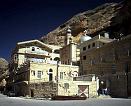 |
| in Syria |
|
Español | عربي |
Introduction The ancient and predominantly Christian village of Maalula is located in the eastern slopes of Al-Qalamoun mountains (Anti-Lebanon mountains), southern Syria about 50 km north of Damascus. It is situated at an altitude of more than 1500 metres. The houses are built on the slopes of a huge cirque of rocks that encloses the village; the houses are constructed of stones with flat beam roofs. Most of the houses have blue plaster on the outside, a Christian custom. There are two monasteries here; Saint Sergius (Sarkis) and Saint Thecla (Tekla). Most of the inhabitants are Greek-Catholic and have preserved in their spoken language a dialect of Syriac (Aramaic), the language spoken by Christ. Two neighbouring villages, Jabaadin and Najaa also speak the same language. The word Maalula means 'entrance' in Aramaic. The Catholic monastery of Saint Sarkis (St. Sergius) has inside it a small Byzantine church whose altar has raised sides, like the pagan altars of Roman templeshas; This Byzantine church and Byzantine-period tombs are cut into the rock behind. The Orthodox monastery, Mar Takla (St. Thecla), has a modern church. History Relics, boulders and caverns carved in the rocks relate the history of thousands of years from the Aramaean era, when Maalula was part of the kingdom of Homs. During the Roman era it was named Seliocopolis. Maalula played an important religious role during the Byzantine era, as it became at the fourth century A.D. the centre of an episcopate that lasted until the 17th century. The Aramic language witch is still spoken in Maalula is an extremely ancient language current in the Middle east during the first millennium before Christ. Two books of the Bible, Daniel and Esdras, were written in Western Aramaic. It was also the language of Christ. The Lord's Prayer, the prayer of Christians all over the world, was first spoken in Aramaic; the monks of Mar Sarkis have made a recording of it in this language. Attractions and historical building An excursion to Maaloula can be easily combined with a visit to another Christian site, the convent at Seidnaya, 30 kilometres to the south-west, towards Damascus |
|||||||||||||||||||||||||||||||||||||||||||||||||||||
|
|
||||||||||||||||||||||||||||||||||||||||||||||||||||
|
|
|
|

Custom Search
|
| © Copyright Homsonline.com |
| |
||
| |
|
|

